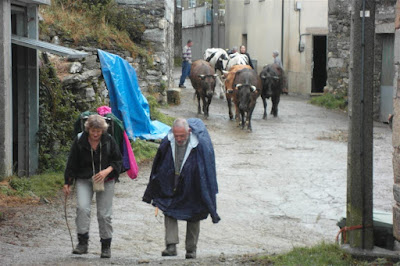We started off when there was just enough light so that we could cover the last 9 km of our long journey and arrive at Santiago in time for the daily mass at noon.
Last night there was a period of very heavy downpour and we wondered if that would accompany us today. It was drizzling as we left and of course when we got to Monte do Gozo at the outer edge, Santiago was hidden behind a veil of mist and rain.
Soon we were venturing into the urban streets of Santiago and as in any other cities we dodged the cars and raced across pedestrian crossings. No worries about cow dung piles anymore!
Up a gentle slope, through one of the gates to the old town (Porto Do Camino) and we were there in Prazo Obradoiro and in front of us, the end of our journey, the end of the Camino de Santiago, was the Cathedral of Santiago de Compostela.
We had more than an hour before the daily noon mass so our first call was to the Pilgrim's Office to have the last stamp on our credentials and receive a certificate of our achievement. The document was in Latin (we would need to read tbe translation but we are sure it said something nice). K's name was entered in the Latin form of Catuarinam whereas mine was wisely left alone in the original form by the lady who received me. We gladly accepted their congratulations.
We left the office and returned to tbe Cathedral for the mass (held in Spanish of course) and the spectacular and eagerly awaited swinging of the giant incence burner.
Outside in the Prazo the crowd resembled a post graduation ceremony celebration. Even the sun came out behind the clouds, briefly.
(This completes the blog but it will be updated with some photos and edited to improve content. For new postings please revert to http://reshui.blogspot.com)
Last night there was a period of very heavy downpour and we wondered if that would accompany us today. It was drizzling as we left and of course when we got to Monte do Gozo at the outer edge, Santiago was hidden behind a veil of mist and rain.
Soon we were venturing into the urban streets of Santiago and as in any other cities we dodged the cars and raced across pedestrian crossings. No worries about cow dung piles anymore!
Up a gentle slope, through one of the gates to the old town (Porto Do Camino) and we were there in Prazo Obradoiro and in front of us, the end of our journey, the end of the Camino de Santiago, was the Cathedral of Santiago de Compostela.
We had more than an hour before the daily noon mass so our first call was to the Pilgrim's Office to have the last stamp on our credentials and receive a certificate of our achievement. The document was in Latin (we would need to read tbe translation but we are sure it said something nice). K's name was entered in the Latin form of Catuarinam whereas mine was wisely left alone in the original form by the lady who received me. We gladly accepted their congratulations.
We left the office and returned to tbe Cathedral for the mass (held in Spanish of course) and the spectacular and eagerly awaited swinging of the giant incence burner.
Outside in the Prazo the crowd resembled a post graduation ceremony celebration. Even the sun came out behind the clouds, briefly.
(This completes the blog but it will be updated with some photos and edited to improve content. For new postings please revert to http://reshui.blogspot.com)





















